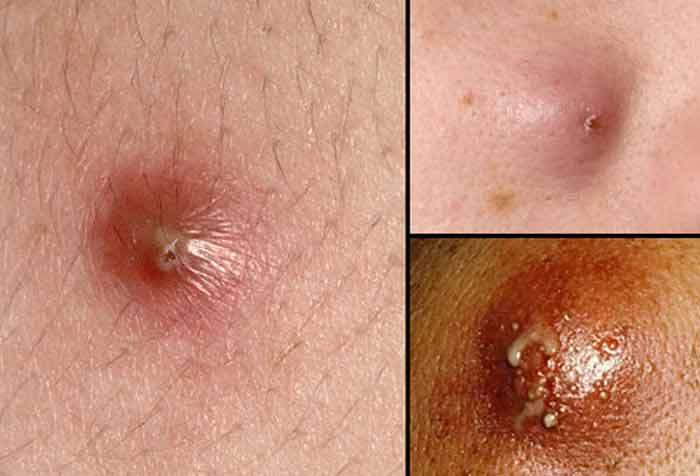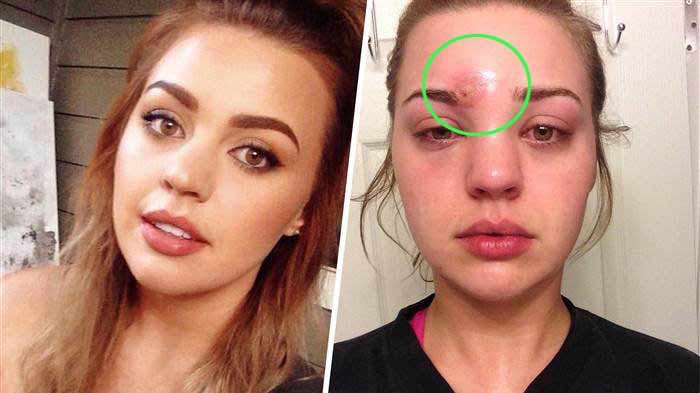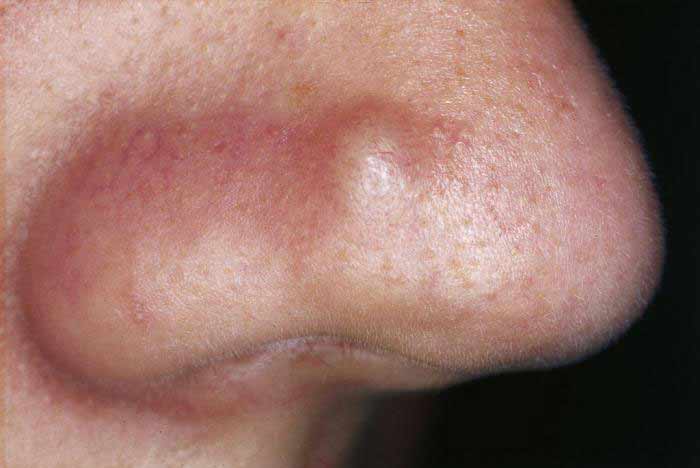How can pimples get infected? How is it linked to yeast and staph infection? Read to find the causes, symptoms, parts of the body that are mostly affected plus treatment and ways to get rid fast.
Can Pimples get Infected?
People normally talk of pimples without really understanding what they are. Pimples is a general term referring to the common whiteheads and the blackheads. In short, the comedone mostly seen in acneiform eruptions.
When you talk about pimples, then you point out to different types that are characterized by different signs and symptoms. These shall be discussed in detail in the later sections of the article. Here are the types of pimples:
- Whiteheads: these are pimples that are located underneath the skin and are known as closed comedone. This is because they contain pus that has not drained.
- Blackheads: when the whiteheads drain their pus, then the comedone that is formed is known as open comedone. Unlike the whiteheads, the blackheads are located on the surface of the skin. Due to the oxidation of melanin, which is the skin’s pigment, the blackhead can range from black to dark brown in color.
- Pustules: when the pimples contain pus, they are known as pustules. Pus in an indication that the lesion is infected.
- Papules: these are non-infected pimples and hence contain no pus.
From the types of pimples, it is therefore possible for them to get infected and form a pus-filled sac known as a whitehead or pustule.

Causes
Pimples are primarily caused by the presence of clogged sebaceous glands. These glands are responsible for the secretion of sebum and thus referred to as the oil glands of the skin. When this happens, then it is much easier for the clogged up pores to get infected. Why is this so?
Sebum is known to have some mild antiseptic properties and hence augments the physical barrier the skin offers to pathogens.
The reason the pimple is swollen is due to the inflammation that follows when an immune response is instituted so as to combat the pathogens.
There are a number of causes of pimples that are linked to infections. The common pathways are either through an imbalance of normal flora of the skin and the gut or hormonal:
Puberty and skin infection
During this stage of life, there are hormonal changes in both males and females. A surge of testosterone in males and females results in the over-secretion of sebum by the sebaceous glands that are located at the base of the hair follicles.
This hyperactivity is what results in comedone that are characteristic of acneiform eruptions. Pimples in acne vulgaris affects more than 80% of teenagers and this prevalence reduces in adulthood with only 3% of men and 12% of women.
When sebum produced is high in amount, it favors the colonization of Propionibacterium acnes, a type of bacteria that is responsible for the pathophysiology of acneiform eruptions.
An imbalance in the normal flora of the skin and infections
There are good and bad bacteria. In and on your body, there needs to be a balance between the two in a 5:1 ratio in which for every 5 good bacteria there is one pathogenic bacteria.
Failure to achieve this balance results in what is known as a dysbiosis. This balance occurs through the action of these probiotic bacteria on the microbiological, immunological and epithelial and influence on the gut-brain-skin axis.
As purported in a publication in the American Journal of Clinical Dermatology in 2008, where probiotic bacteria were indicted for the treatment of eczema, it is also possible to have the same explanation to pimple eruptions on your skin.
Increased sensitivity to testosterone and eruption of pimple
As explained before, the presence of this hormone in the skin and its binding to the receptors results in overproduction of sebum. The steps that follow into formation of an acne or pimple eruption are as mentioned before with a principal influence on the increased colonization of bacteria and accumulation of dirt which leads to pimples.
Polycystic Ovarian Syndrome (PCOS) and association with pimples:
this is a medical condition in which there is a hormonal imbalance. In this condition, among others such as congenital adrenal hyperplasia, the adrenal tumor or Cushing’s syndrome, there is an increase production of androgens in the female.
This could therefore lead to pimples when the hormone increases production of sebum and hence infections may arise thereof.
Infections
Pimples could arise from infections due to fungal or bacterial pathogens. Fungal infections mostly occur in immunosuppressed individuals either due to a co-morbidity with HIV/AIDs or in individuals who are on immunosuppressive drugs such as anticancer o agents.
With reference to the previous causes, pathogens enjoy the warmth and sebum culture presented as conducive.
Medication
While it may seem weird, Lisa A. Garner, MD, FAAD, a clinical professor of dermatology at the University of Texas Southwestern Medical Center confirms that drugs such as the anti-aging hormone dihydroecosaenoic acid, DHEA, iodide or bromide containing drugs and barbiturates can cause acneiform eruptions which can be infected.
Symptoms
Now that you are well conversant with the causes of infected pimples, it is also imperative to be able to identify the signs and symptoms of an infected pimple regardless of the cause.
An infected pimple basically has similar presentation clinically in relation to different etiologies. When your pimple is infected, you will be able to observe:
Pustule
The infected pimple will be known as a pustule if it is infected. This means that it contains pus. Pus is a fluid that has a characteristic yellow or green color due to the pathogen in question and the presence of dead white blood cells.
The pus is also foul smelling. Failure to treat infected pimples may lead to complications such as boils and carbuncles.
Inflammation
An immune response to a breach on the skin as occurs in pimples leads to inflammation. Pimples themselves are inflammations. However, infected pimples tend to complicate into cysts and abscesses if not taken care of earlier.
The cysts or abscesses are normally of a red color. There are areas on your body that are prone to infected pimples including the shoulders, skin, the genitals and inner thighs and the chest (National Health Service). Inflammation comes with redness and swelling as one of its cardinal signs.
Lymphadenitis
This generally refers to an inflammation of the lymph nodes. These are parts of the body that are involved in the institution of immune responses. Therefore, if they are swollen, then this could mean that they are struggling to eliminate some pathogen.
Cellulitis
This is a bacterial infection of the tissues of the skin. The condition presents with infected pimples or zits. Acne spots may also occur. The pimples resulting from this are really tender and sensitive to touch or pressure.
Formation of scabs when popped
This is particularly the reason why you are advised not to pop pimples. They tend to bleed and ooze out some pus then later form scabs which are black or brown in color.
Those with acne are most predisposed to scabs as they tend to pop the comedones. There are ways in which you can avoid the formation of scabs and this may include the use of benzoyl peroxide or Neosporin when you have popped your pimples.
Pimples may resemble a rash and blisters
The rash in question is that which looks like herpes. You could also get blisters. However, blisters are rarely infected as the fluid is water-like in color.
This section briefly describes why pimple infection may appear in the following places and possible complications that occur in the respective areas.
On Face
You have probably observed that pimples occur on the face more than other body parts. This is because the area is more prone to exposure to touch among other contaminants.

You will find yourself wiping you face without use of a cloth at times which exposes the face to pathogens that may infect breached skin.
In addition to this, the face has a higher population of sebaceous glands as compared to other parts of the body. Sebum may harbor bacteria such as the Propionibacterium acnes which has also been implicated as a cause of infected pimples.
High amounts of sebum could cause whiteheads that when popped could get infected too. acneiform eruptions and scabs may form.
PubMed Health mentions that food such as chocolate and those that are greasy could lead to pimples while a research by Yosipovitch G et al, 2007reveals that psychological stress could lead to high sebum production due to high prevalence among those with stress. Also, use of comedogenic cosmetics. Remember that these could be infected.
On Nose
The nose is part of the face and could get infected pimples by virtue of the large number of sebaceous glands
To add, the nasal passage is a highly potent harbor for Staphylococcus aureus, a normal skin flora among other pathogens.

The air you breathe in contains many pathogens that are fortunately trapped by a mechanistic approach provided by the nasal passage. Tearing up the vasculature of your nose could result in an infection.
On Legs
Though not so common, the presence of infected pimples on the legs could be due to tight clothing worn at times. Tight clothing leads to accumulation of dirt, sweat and sebum in the skin.
On Lips
Pimples occurring on the lips are mostly Fordyce’s spots. These are small bumps of about 1 to 3 mm resembling papules but of sebaceous origin. They occur when the glands are enlarged.
According to Baeder FM (2010)[1] and Chern PL (2008), the presence of subtle sebaceous glands may be the reason for the pimples. When these occur, it is much easier to have them infected.
In Ear
The ear, just like the nasal passage is a canal that needs to be clean. The wax/cerumen is charged with this responsibility. When the ear canal is infected, you can get external otitis or otitis externa. You will therefore develop a pimple.
You can also get this when you injure your canal when you have got some soap or cerumen impaction or swimmer’s ear. There have been cases whereby cerumen impaction has been associated with an infected pimple.
On Back
This might be closely linked to improper hygiene. Rarely do most people wash their backs well.
Moreover, the back is sensitive to dirty clothes and has large number of sweat glands that will need to be relieved. If you have worn some tight clothing, it would hamper this physiology.
To add, there are infections such as syphilis that are associated with pimples on the back or erythema. When scratched, infected pimples could occur.
It could also be bacne (back acne) which may result from mechanical rubbing of the back that leads to irritation such as wearing a backpack, shoulder straps or knapsacks.
On Buttocks
Just as seen in causes of infected pimples on the back, wearing tight clothing and excessive sweating are the biggest culprits.
In children, it could a diaper rash caused by a fungal infection. It could be an ingrown hair along the intergluteal cleft. This may lead to boils and cysts.
Yeast infection and pimples
Yeast or fungal infections are commonly candida and can cause bumps and pimples. This is most prevalent in areas that hold moisture and are warm.
They are itchy, red or pink in color which may turn into painful sores that cluster.
Fungal infections may at times be side effects of treating a bacterial infection with a conventional antibacterial drug.
Staph infection pimple Pictures & Differences
Staph infection or pimple? The two can be linked to each other but are mutually exclusive. A pimple can either be infected or not and it can be infected by a Staph bacterium or not.
When a pimple is infected with a staph bacterium, there will be obvious signs of pus among other signs such as:
- Fever
- Swollen lymph nodes in the armpits, neck or groin
- Fast growing reddening of the pimple.
- Pus production on the infected area
- If it is a Methicillin Resistant Staph Aureus (MRSA), then it may not respond to first line antibiotic treatment i.e. the penicillins.
How to get rid of infected pimple
In order to get rid of an infected pimple(s), then you can do the following:
- Take a shower after working out and make sure you wash your face often with an antibacterial soap then pat dry. Afterwards, reduce on the tight clothing.
- Apply some antibacterial ointment or cream or one that has this component. Your dermatologist will help you choose. It is important to choose non-comedogenic skin products and this information can be got from the label of products.
- You can use lemon juice once a day by applying onto your skin to remove whiteheads. Just cut a piece of lemon, dip it in clean water then use a cotton ball to apply the astringent onto your face. Rub for about 2 minutes then wash off after 15 minutes.
- In the same way as lemon juice, you can use apple cider vinegar which as some antibacterial properties and cleans the skin.
- Use some exfoliating cream to remove debris that clog up your pores and accumulate sebum. Some include Dermalogica Daily Superfoliant and Bioré Baking Soda Acne Scrub. Home exfoliants include a sugar scrub and salicylic acid. The latter can be found in some conventional cream preparations and is a good antibacterial agent too. Since infected pimples could also result from ingrown hairs, it is pertinent to shave well and use the exfoliating creams mentioned in this section.
- Develop a work-out schedule: physical activity will not only relive stress and pimples that arise from it, it also helps you sweat out the toxins in the blood allowing for production of sebum in the process and hence reduce on unhealthy skin. This way, will be able to reduce on pimples whether infected or not.
Treatment options
Conventional interventions for infected pimples that can be used include:
- Antibiotics: includes creams such as fusidic acid, clindamycin or some oral formulations such as flucloxacillin, cloxacillin and amoxicillin/clavulanate. Salicylic acid too apart from the antibacterial properties, prevents comedogenic growth.
- Keratolytics such as resorcinol which doubles as a comedolytic too. Others are retinoids and azelaic acid.
- Analgesics: for the pain and inflammation, you could have some ibuprofen or diclofenac either as an oral dose or topical application.
A dermatologist could also perform a comedone removal surgery.
How to reduce swelling on face
Swelling can be reduced by the intake of anti-inflammatory drugs such as Anti-Inflammatory such as diclofenac, ibuprofen, naproxen among others.
Warm compress would also work as it softens the large pimples and even ripens those that need to be drained.
Is Popping Infected Pimples Safe?
No it isn’t and should not be your first option either. If not done correctly, you may spread the infection.
It is better to have the underlying problem known first through a diagnosis then if need arises to have them popped, it will be done professionally.
References
[1] Baeder FM, Pelino JE, de Almeida ER, Duarte DA, Santos MT (2010) High-power diode laser use on Fordyce granule excision: a case report. J Cosmet Dermatol 9: 321- 324.

